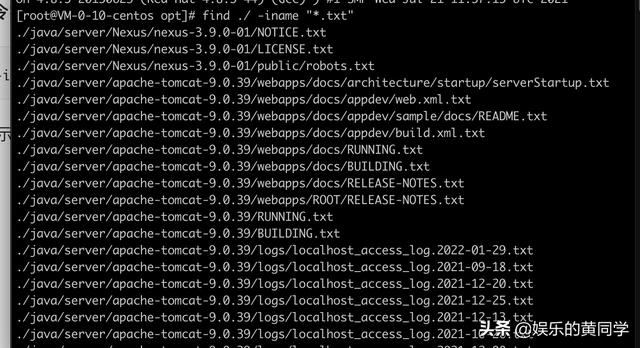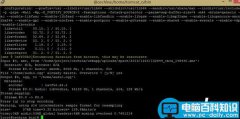演示环境
Linux version 3.10.0-1160.36.2.el7.x86_64 (mockbuild@kbuilder.bsys.centos.org) (gcc version 4.8.5 20150623 (Red Hat 4.8.5-44) (GCC) ) #1 SMP Wed Jul 21 11:57:15 UTC 2021
find用法
用法: find [-H] [-L] [-P] [-Olevel] [-D help|tree|search|stat|rates|opt|exec] [path...] [expression]
默认路径为当前目录;默认表达式为 -print
表达式可能由下列成份组成:操作符、选项、测试表达式以及动作:
操作符 (优先级递减;未做任何指定时默认使用 -and):
( EXPR ) ! EXPR -not EXPR EXPR1 -a EXPR2 EXPR1 -and EXPR2
EXPR1 -o EXPR2 EXPR1 -or EXPR2 EXPR1 , EXPR2
positional options (always true): -daystart -follow -regextype
normal options (always true, specified before other expressions):
-depth --help -maxdepth LEVELS -mindepth LEVELS -mount -noleaf
--version -xautofs -xdev -ignore_readdir_race -noignore_readdir_race
比较测试 (N 可以是 +N 或 -N 或 N): -amin N -anewer FILE -atime N -cmin N
-cnewer 文件 -ctime N -empty -false -fstype 类型 -gid N -group 名称
-ilname 匹配模式 -iname 匹配模式 -inum N -ipath 匹配模式 -iregex 匹配模式
-links N -lname 匹配模式 -mmin N -mtime N -name 匹配模式 -newer 文件
-nouser -nogroup -path PATTERN -perm [-/]MODE -regex PATTERN
-readable -writable -executable
-wholename PATTERN -size N[bcwkMG] -true -type [bcdpflsD] -uid N
-used N -user NAME -xtype [bcdpfls]
-context 文本
操作: -delete -print0 -printf 格式 -fprintf 文件 格式 -print
-fprint0 文件 -fprint 文件 -ls -fls 文件 -prune -quit
-exec 命令 ; -exec 命令 {} + -ok 命令 ;
-execdir 命令 ; -execdir 命令 {} + -okdir 命令 ;
通过 findutils 错误报告页 http://savannah.gnu.org/ 报告错误及跟踪修定过程。如果您无法浏览网页,请发电子邮件至 <bug-findutils@gnu.org>。
使用find 命令实现搜索
find ./ -iname "*.txt"
随便找个目录演示一下:

-iname 是不区分大小写。-name 要区分大小写。*是通配符就不多讲了,也可替换成正则表达式。find ./ (等价于find .)命令,可以把当前文件夹下的所有内容全部列出来

grep用法
用法: grep [选项]... PATTERN [FILE]...
在每个 FILE 或是标准输入中查找 PATTERN。
默认的 PATTERN 是一个基本正则表达式(缩写为 BRE)。
例如: grep -i 'hello world' menu.h main.c
正则表达式选择与解释:
-E, --extended-regexp PATTERN 是一个可扩展的正则表达式(缩写为 ERE)
-F, --fixed-strings PATTERN 是一组由断行符分隔的定长字符串。
-G, --basic-regexp PATTERN 是一个基本正则表达式(缩写为 BRE)
-P, --perl-regexp PATTERN 是一个 Perl 正则表达式
-e, --regexp=PATTERN 用 PATTERN 来进行匹配操作
-f, --file=FILE 从 FILE 中取得 PATTERN
-i, --ignore-case 忽略大小写
-w, --word-regexp 强制 PATTERN 仅完全匹配字词
-x, --line-regexp 强制 PATTERN 仅完全匹配一行
-z, --null-data 一个 0 字节的数据行,但不是空行
Miscellaneous:
-s, --no-messages suppress error messages
-v, --invert-match select non-matching lines
-V, --version display version information and exit
--help display this help text and exit
输出控制:
-m, --max-count=NUM NUM 次匹配后停止
-b, --byte-offset 输出的同时打印字节偏移
-n, --line-number 输出的同时打印行号
--line-buffered 每行输出清空
-H, --with-filename 为每一匹配项打印文件名
-h, --no-filename 输出时不显示文件名前缀
--label=LABEL 将LABEL 作为标准输入文件名前缀
-o, --only-matching show only the part of a line matching PATTERN
-q, --quiet, --silent suppress all normal output
--binary-files=TYPE assume that binary files are TYPE;
TYPE is 'binary', 'text', or 'without-match'
-a, --text equivalent to --binary-files=text
-I equivalent to --binary-files=without-match
-d, --directories=ACTION how to handle directories;
ACTION is 'read', 'recurse', or 'skip'
-D, --devices=ACTION how to handle devices, FIFOs and sockets;
ACTION is 'read' or 'skip'
-r, --recursive like --directories=recurse
-R, --dereference-recursive
likewise, but follow all symlinks
--include=FILE_PATTERN
search only files that match FILE_PATTERN
--exclude=FILE_PATTERN
skip files and directories matching FILE_PATTERN
--exclude-from=FILE skip files matching any file pattern from FILE
--exclude-dir=PATTERN directories that match PATTERN will be skipped.
-L, --files-without-match print only names of FILEs containing no match
-l, --files-with-matches print only names of FILEs containing matches
-c, --count print only a count of matching lines per FILE
-T, --initial-tab make tabs line up (if needed)
-Z, --null print 0 byte after FILE name
文件控制:
-B, --before-context=NUM 打印以文本起始的NUM 行
-A, --after-context=NUM 打印以文本结尾的NUM 行
-C, --context=NUM 打印输出文本NUM 行
-NUM same as --context=NUM
--group-separator=SEP use SEP as a group separator
--no-group-separator use empty string as a group separator
--color[=WHEN],
--colour[=WHEN] use markers to highlight the matching strings;
WHEN is 'always', 'never', or 'auto'
-U, --binary do not strip CR characters at EOL (MSDOS/Windows)
-u, --unix-byte-offsets report offsets as if CRs were not there
(MSDOS/Windows)
‘egrep’即‘grep -E’。‘fgrep’即‘grep -F’。
直接使用‘egrep’或是‘fgrep’均已不可行了。
若FILE 为 -,将读取标准输入。不带FILE,读取当前目录,除非命令行中指定了-r 选项。
如果少于两个FILE 参数,就要默认使用-h 参数。
如果有任意行被匹配,那退出状态为 0,否则为 1;
如果有错误产生,且未指定 -q 参数,那退出状态为 2。
请将错误报告给: bug-grep@gnu.org
GNU Grep 主页: <http://www.gnu.org/software/grep/>
GNU 软件的通用帮助: <http://www.gnu.org/gethelp/>
find +grep
grep 命令可以根据关键词进行过滤
find ./ | grep txt
这个命令可以把当前目录里面的所有文件名中包含 txt 的全部列出来。另外,我们还可以组合多个关键词进行进一步的过滤,只要在后面接着输入 | grep 关键词即可。
find ./ | grep txt | grep log

-v这个是取反功能
find ./ | grep txt -v
简单做个笔记,以后实际用到再补充。以上用法都是看网上的人使用的多的。




![RedHat服务器上[Errno 5] OSError: [Errno 2]的解决方法](https://img.pc-daily.com/uploads/allimg/4752/11135115c-0-lp.png)

